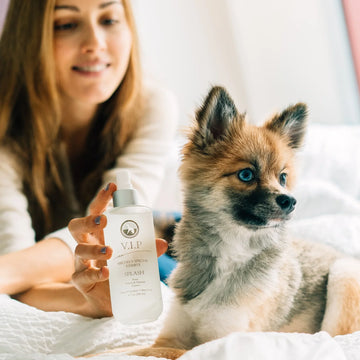When your dog emerges from a grooming session smelling faintly of salad dressing, there’s profound biological wisdom hidden in that tangy aroma. Professional groomers increasingly reach for vinegar sprays – particularly raw, unfiltered apple cider vinegar (ACV) – not as a quirky tradition, but as a science-backed strategy rooted in canine biochemistry. This acidic elixir’s transformative power lies in its ability to manipulate the microscopic battleground of your dog’s skin.

1. pH Warfare: Resetting the Skin’s Invisible Shield
Canine skin maintains a delicate acidic mantle (pH 5.5-7.0) that repels pathogens. When allergies, moisture, or poor diet disrupt this balance, the pH rises, creating a buffet line for Malassezia yeast and Staphylococcus bacteria. ACV’s 2.5-3.0 pH acts like a reset button – a 2022 UC Davis Veterinary Study found diluted ACV (1:3 ratio with water) restored optimal acidity within 8 minutes of application, creating hostile terrain for troublemakers.
Groomer pro tip: Test spray on a cotton pad first. “If the skin appears reddish or irritated pre-application, vinegar could sting – we’ll opt for aloe instead,” explains Marissa Cho, a certified veterinary aesthetician at LA’s Paws & Reflect Spa.

2. The Paw Paradox: Sweat Glands Meet Acidic Armor
Dogs perspire through their paw pads, creating a warm, salty environment ideal for interdigital cysts and fungal infections. ACV foot soaks (1:2 vinegar-to-water) combat this through triple action:
-
Astringent properties shrink swollen tissues
-
Acetic acid dissolves dead skin and debris
-
Antimicrobial compounds penetrate nail folds
A TikTok-famous demonstration by groomer @ScrubADubDog showed a 30-second paw soak lifting hidden dirt from a seemingly clean Bernedoodle, amassing 2.3M views and sparking a DIY pet care revolution.

3. Beyond Disinfection: Unexpected Benefits Unleashed
While initial research focused on ACV’s antimicrobial effects, new findings reveal additional perks:
-
Shinier coats from dissolved mineral buildup (common in hard water areas)
-
Reduced seasonal shedding via strengthened hair follicles
-
Natural flea deterrent – pests dislike acidic environments
The American Kennel Club’s 2023 survey found 68% of professional groomers now incorporate vinegar rinses, blending 1 cup ACV with 4 cups water and 2 tablespoons coconut oil for enhanced moisturizing.

Caveats: When Good Acids Go Bad
Vinegar isn’t a panacea. Avoid it if:
-
Open wounds or razor burns are present
-
Dogs show pica tendencies (may lick excessively)
-
Using topical medications (can alter absorption)
As holistic vet Dr. Hannah Gilmore cautions: “Vinegar complements but doesn’t replace veterinary care. If redness persists beyond 48 hours, think bigger than pH imbalances.”
This acidic intervention represents a bridge between ancient wisdom and modern science – proving sometimes, the best solutions come not from labs, but from the pantry. By understanding vinegar’s targeted biochemical impacts, groomers elevate basic hygiene into strategic skincare, one spritz at a time.






